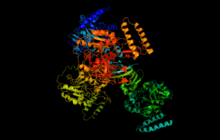UTP—glucose-1-phosphate uridylyltransferase
| UTP—glucose-1-phosphate uridylyltransferase | |||||||||
|---|---|---|---|---|---|---|---|---|---|
 UDP-glucose pyrophosphorylase pictured in pymo | |||||||||
| Identifiers | |||||||||
| EC number | 2.7.7.9 | ||||||||
| CAS number | 9026-22-6 | ||||||||
| Databases | |||||||||
| IntEnz | IntEnz view | ||||||||
| BRENDA | BRENDA entry | ||||||||
| ExPASy | NiceZyme view | ||||||||
| KEGG | KEGG entry | ||||||||
| MetaCyc | metabolic pathway | ||||||||
| PRIAM | profile | ||||||||
| PDB structures | RCSB PDB PDBe PDBsum | ||||||||
| Gene Ontology | AmiGO / EGO | ||||||||
| |||||||||
UTP—glucose-1-phosphate uridylyltransferase also known as glucose-1-phosphate uridylyltransferase (or UDP–glucose pyrophosphorylase) is an enzyme associated with glycogenesis. It synthesizes UDP-glucose from glucose-1-phosphate and UTP; i.e.,
- glucose-1-phosphate + UTP UDP-glucose + pyrophosphate
UTP—glucose-1-phosphate uridylyltransferase is an enzyme found in yeast, plants, and mammals as it is a key player in carbohydrate metabolism. It has been studied significantly in plants as sugar metabolism and production is seen as important for understanding growth from an agricultural standpoint. Recently, human UDP-glucose pyrophosphorylase has been studied and crystallized, revealing a different type of regulation than other organisms previously studied. Its significance is derived from the many uses of UDP-Glucose including galactose usage, glycogen synthesis, glycoprotein synthesis, and glycolipid synthesis.[1] [2][3]
Examples
Human genes encoding proteins with UTP—glucose-1-phosphate uridylyltransferase activity include:
|
| ||||||||||||||||||||||||||||||||||||||||
Function
In many species, UDP-glucose pyrophosphorylase occupies a central role in carbohydrate metabolism. Its product, UDP-glucose, is involved in multiple pathways and is a precursor for other sugar nucleotides. In leaves, UDP–glucose pyrophosphorylase is a key part of the sucrose biosynthesis pathway, supplying Uridine diphosphate glucose to Sucrose-phosphate synthase which converts UDP-Glucose and D-fructose 6-phosphate into sucrose-6-phosphate.[4] It may also be partially responsible for the breakdown of sucrose in other tissues using UDP-Glucose.
Mechanism
In this enzyme’s primary reaction the phosphate group on glucose-1-phosphate replaces the phosphoanhydride bond on UTP. As this reaction is relatively common and spontaneous, the Gibbs Free Energy is close to zero, however, inorganic pyrophosphatase quickly hydrolyzes the pyrophosphate and drives the reaction forward.
Regulation
Although functionally similar across species, UDP-glucose pyrophosphorylase has different structures and regulation mechanisms in different organisms.
Plants
UDP–glucose pyrophosphorylase in plants is regulated through oligomerization and possibly phosphorylation.[5] In barley, it has been shown that UDP-glucose pyrophosphorylase is only active in monomeric form but readily forms oligomers.
Humans
In humans, UDP-glucose pyrophosphorylase is active as an octamer.[6] This in turn lowers the activity of human UDP-glucose pyrophosphorylase compared to yeast UDP-glucose pyrophosphorylase. The difference in structure is potentially explained by the different UDP-glucose requirements of organisms with lower organisms such as yeast requiring more UDP-glucose than higher organisms such as mammals.[7]
Disease relevance
In humans, galactosemia is a disorder that affects the development of newborns and children as they cannot metabolize the sugar galactose properly. It is speculated that overexpression of UDP-Glucose pyrophosphorylase may relieve symptoms in humans with galactosemia.[8] The enzyme has also been found to be required for the biosynthesis of capsular polysaccharide, an important virulence factor of streptococcus pneumoniae, a bacterial cause of pneumonia, bronchitis, and other breathing issues.[9]
References
- ↑ Sandhoff K, van Echten G, Schröder M, Schnabel D, Suzuki K (Aug 1992). "Metabolism of glycolipids: the role of glycolipid-binding proteins in the function and pathobiochemistry of lysosomes". Biochemical Society Transactions. 20 (3): 695–699. doi:10.1042/bst0200695. PMID 1426613.
- ↑ Sandhoff K, van Echten G, Schröder M, Schnabel D, Suzuki K (Aug 1992). "Metabolism of glycolipids: the role of glycolipid-binding proteins in the function and pathobiochemistry of lysosomes". Biochemical Society Transactions. 20 (3): 695–699. doi:10.1042/bst0200695. PMID 1426613.
- ↑ Alonso MD, Lomako J, Lomako WM, Whelan WJ (Sep 1995). "A new look at the biogenesis of glycogen". FASEB Journal. 9 (12): 1126–1137. PMID 7672505.
- ↑ Mendicino J (Dec 1960). "Sucrose phosphate synthesis in wheat germ and green leaves". The Journal of Biological Chemistry. 235: 3347–3352. PMID 13769376.
- ↑ Kleczkowski LA, Geisler M, Ciereszko I, Johansson H (Mar 2004). "UDP-glucose pyrophosphorylase. An old protein with new tricks". Plant Physiology. 134 (3): 912–918. doi:10.1104/pp.103.036053. PMID 15020755.
- ↑ Yu Q, Zheng X (Mar 2012). "The crystal structure of human UDP-glucose pyrophosphorylase reveals a latch effect that influences enzymatic activity". The Biochemical Journal. 442 (2): 283–291. doi:10.1042/BJ20111598. PMID 22132858.
- ↑ Yu Q, Zheng X (Mar 2012). "The crystal structure of human UDP-glucose pyrophosphorylase reveals a latch effect that influences enzymatic activity". The Biochemical Journal. 442 (2): 283–291. doi:10.1042/BJ20111598. PMID 22132858.
- ↑ Lai K, Elsas LJ (May 2000). "Overexpression of human UDP-glucose pyrophosphorylase rescues galactose-1-phosphate uridyltransferase-deficient yeast". Biochemical and Biophysical Research Communications. 271 (2): 392–400. doi:10.1006/bbrc.2000.2629. PMID 10799308.
- ↑ Bonofiglio L, García E, Mollerach M (Oct 2005). "Biochemical characterization of the pneumococcal glucose 1-phosphate uridylyltransferase (GalU) essential for capsule biosynthesis". Current Microbiology. 51 (4): 217–221. doi:10.1007/s00284-005-4466-0. PMID 16132460.
External links
- UDP Glucose Pyrophosphorylase at the US National Library of Medicine Medical Subject Headings (MeSH)